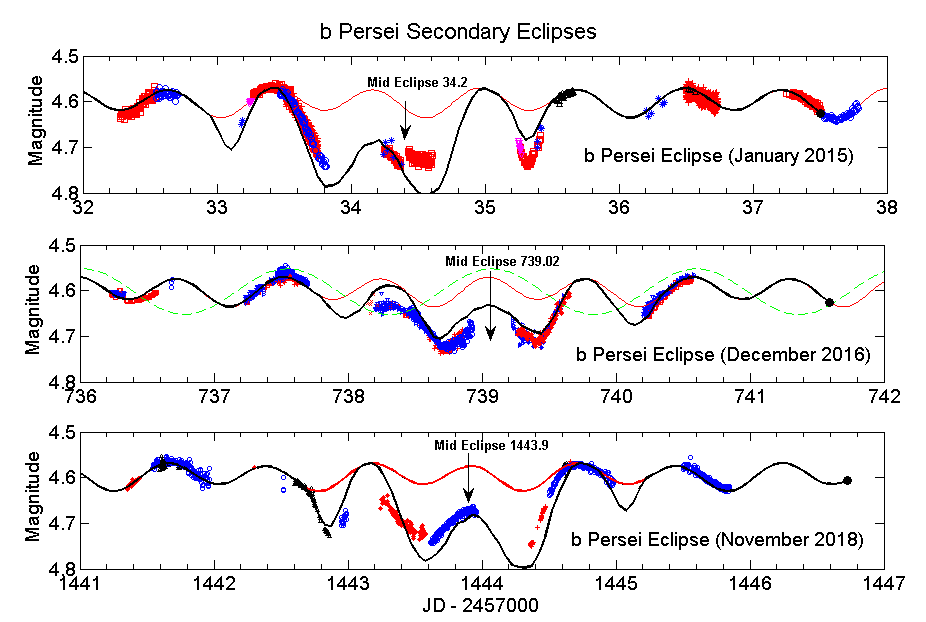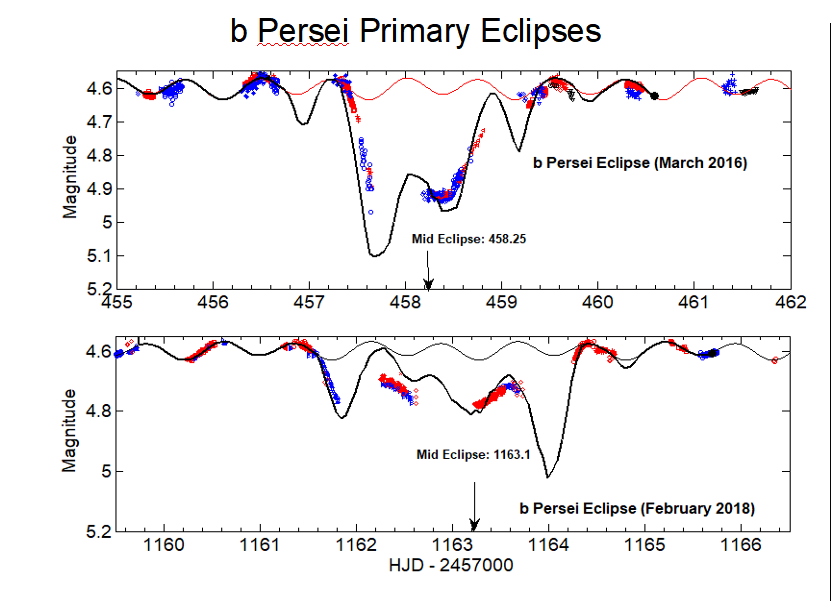December 20, 2019
AAVSO Forum thread (scroll to the bottom of a thread for latest posts):
- Campaigns & Observation Reports: https://www.aavso.org/b-per-campaign-january-2020
The bright (4.6 V) triple-star, eclipsing system b Persei [not beta Per] has been the subject of several AAVSO campaigns (AAVSO Alert Notices 476 (20130104), 507 (20150107), 537 (20160226), 563 (20161202), 610 (20180126) and 655 (20181030)).
Dr. Donald F. Collins (AAVSO member), Dr. Robert Zavala (US Naval Observatory, Flagstaff Station), Jason Sanborn (Lowell Observatory), and Dr. Anatoly Miroshnichenko (University N. Carolina, Greensboro) are requesting high time-resolved observations of the bright star b Persei (magnitude 4.6) during the upcoming predicted primary eclipse, or transit, of the third star across the system. The observation window should be centered about 2 weeks either side of the predicted mid-eclipse date of January 19, 2020 UT (Jan. 5 to Feb. 2, 2020).
The b Persei system (HIP 20070, SAO 24531, HR 1324, HD 26961) consists of three stars in a hierarchical system. The A and B components are close-orbiting (1.5237 d period) in a low-inclined orbit that exhibits ellipsoidal variation (~0.06 magnitude variation) with no eclipses. The brightest star of the pair is spectral class A2V. The other two stars in the system are believed to be spectral class F (G. Hill et al., 1976, ApJ, 208,152). The recent campaigns by AAVSO observers have revealed the following: 1) Both the primary and secondary transits show significant light curve dips in total brightness on the order of 0.15 mag to 0.3 mag. 2) The orbital period for the C star is 704.90 ± 0.05 d based on the time difference between successive transits of the same primary/secondary phase of the C orbit. The previously published orbital period is 702 d (Hill1976). 3) Radial velocity observations by Anatoly Miroshnichenko, which separate the short period RV oscillations from the long period RV oscillation, have indicated that the eclipses observed in Jan. 2015, Dec. 2016, and Nov. 2018 (Figure 1) were secondary eclipses in which the C star transits behind the A-B pair. At present we have observed only two primary eclipses: Mar 2016 and Feb. 2018 (Figure 2), in which the C star temporarily blocks some of the light from the close-orbiting A-B pair.
Photometry
Observers are asked to obtain high-resolution time-series observations of long durations in V (or the green channel from DSLR) during the eclipses as well as a few time-series observations of the system out of eclipse during the two weeks before and after the expected mid-eclipse date of January 19, 2020 eclipse (Jan. 5 to Feb. 2, 2020). Out of eclipse data are important to calibrate the various offsets expected from different observing systems. It is recommended to use the star labeled '55' ( AUID 000-BLL-386 = HIP 20156 = SAO 39457 = HR 1330 = HD 270840) in the AAVSO finder chart at 5.456 V as the comparison star. For a check star HIP 20370 (J2000 RA, Dec = 04 21 45.47 +50 02 06.64) may be used if the observer's field of view is about one degree. This star is not in the AAVSO sequence. Any other AAVSO sequence stars may be used as a check star if available in the observer's field of view. New observers are welcome - especially Asian and Pacific observers to help fill the gaps in the transit light curves.
Guidelines for observing bright stars for both CCD and DSLR cameras may be found in the Alert Notices mentioned above for the earlier campaigns. DSLR guidelines may also found in the AAVSO DSLR Observing Manual (/dslr-observing-manual).
Please submit all photometry data to the AAVSO International Database via WebObs at the AAVSO site, using the name b PER. A thread on the AAVSO Campaigns & Observation Reports forum [https://www.aavso.org/b-per-campaign-january-2020] will be maintained to advise observers of latest developments: eclipse onsets, observing ideas.
Spectroscopy
Spectroscopy will also be extremely valuable, especially during this primary eclipse in which the C star will block some of the light from the A and B stars at different times throughout the eclipse. We hope to see small changes in some parts of the spectra if the A or B stars are totally or partially eclipsed. It will be especially valuable if spectra obtained an eclipse of the A star that will reveal any rotational RV shifts of the A star. Please send any spectroscopy observations to Dr. Anatoly Miroshnichenko <a_mirosh@uncg.edu>. All spectroscopy data should be displayed with the following guidelines:
The FITS header should include: coordinates of the observing place; the observer name, RA & DEC of the star, UT time of the observation (better mid-point), exposure time in seconds. The intensities need to be in ADU (not normalized to the continuum) and wavelength scale needs to be geocentric.
If the standard cannot be met, Dr. Miroshnichenko would need specific explanations of the data-taking circumstances.
Coordinates (J2000.0): R.A. 04 18 14.62 Dec. +50 17 43.8
AAVSO finder charts with comparison stars, including the 55 requested above, may be generated using the AAVSO Variable Star Plotter (VSP).
Figure 1. The three previously-observed secondary eclipses of b Persei. The solid black curves are a simple model fit to to the observations. The different colors and symbols in the observations represent the individual observations contributed by the various observers. The dashed sinusoidal curve in the middle panel represents the graphical radial velocity based on data from A. Miroshnichenko. The solid sinusoidal curves in each panel represent the fit to ellipsoidal data.

Figure 2. The two previously-observed by AAVSO primary eclipses of b Persei. The different colors and symbols for the observations represent the different observers who contributed to the data. The solid black curves are a simple model fit to to the observations. The lighter sinusoidal curves represent the fit to ellipsoidal data.
References:
AAVSO Alert Notice 476, January 4, 2013.
AAVSO Alert Notice 507, January 7, 2015.
AAVSO Alert Notice 537, February 26, 2016.
AAVSO Alert Notice 563, December 2, 2016.
AAVSO Alert Notice 610, January 26, 2018.
AAVSO Alert Notice 655, October 30, 2018.
Buchheim, Robert K. 2018, “Lessons from DSLR Photometry of b Per “Third Star” Eclipse (February 2018)”, SAS-2018 The Symposium on Telescope Science and ALPO Annual 2018 Meeting, Proceedings for the 37th Annual Conference of the Society for Astronomical Sciences. [http://www.socastrosci.org/Publications.html].
Hill, G. 1976, Aikman, G. C. L., Cowley, A. P., Bolton, C. T., & Thomas, J. C. 1976, ApJ, 208, 152.
This AAVSO Alert Notice was compiled by Elizabeth O. Waagen from material provided by Dr. Collins.
---------------------------------
SUBMIT OBSERVATIONS TO THE AAVSO
Information on submitting observations to the AAVSO may be found at:
https://www.aavso.org/webobs
ALERT NOTICE ARCHIVE AND SUBSCRIPTION INFORMATION
An Alert Notice archive is available at the following URL:
https://www.aavso.org/aavso-alert-notices-for-observing-campaigns-and-discoveries
Subscribing and Unsubscribing may be done at the following URL:
https://www.aavso.org/aavso-alert-notice-subscribe
-------------------------------------------------
Please support the AAVSO and its mission -- Join or donate today:
https://www.aavso.org/apps/donate/

